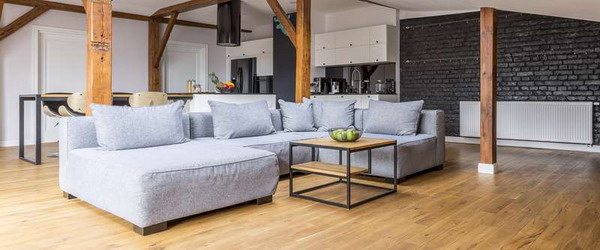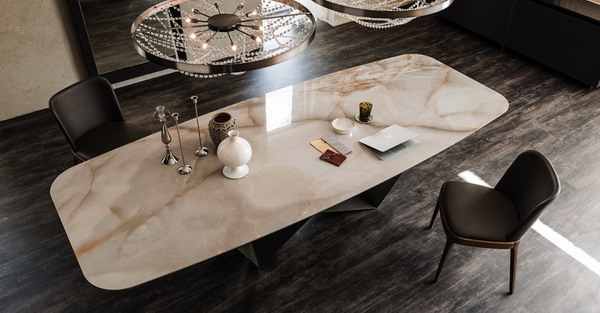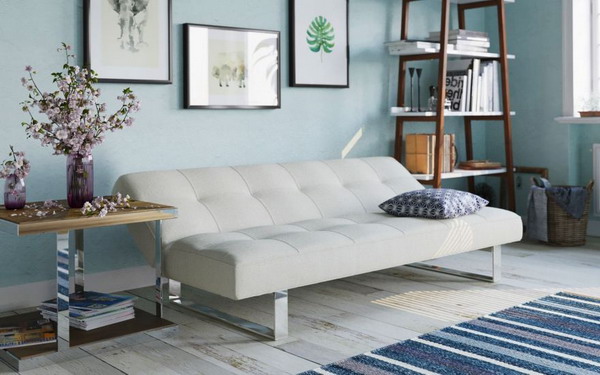Natural floors: Living naturally with floorboards, parquet and cork
Natural floors made of wood are popular again today as natural floor coverings. Cork and wood offer invaluable advantages and contribute to a healthy living environment.
Natural floors in the house: criteria for selection
Natural floors are popular again today as an alternative to the long-established floor coverings such as PVC or carpeting. The focus is not only on the desire for healthy living, but also for a durable floor that can withstand heavy loads with as little abrasion as possible. Aesthetic, robust, healthy and good for the room climate: floors made of wood and cork can easily meet all these requirements. However, it is important to pay attention to a few points when making your selection.

Three important aspects for choosing the right natural flooring
The question is not only whether high-quality solid wood floorboards, parquet, laminate or a floor with a cork covering should come into the living room.
When selecting the right natural flooring, there are a few points to consider, such as these:
- abrasion class
The abrasion class indicates how resilient the natural floors are. From this, in turn, conclusions can be drawn as to which living areas the individual floor coverings are intended for. The following applies: the higher the abrasion class, the more resilient the floor. Abrasion class 21 is suitable for bedrooms and storage rooms and therefore for rooms that are less frequented. The abrasion class 23 is different, which is suitable for all heavily used floors and is ideal in hallways and kitchens. At least abrasion class 22 should be laid in living rooms and children’s rooms.
- underfloor heating
Underfloor heating is standard in many new buildings, but not always in older buildings. At the same time, not all natural floors are suitable for underfloor heating. So if you want to lay floorboards, for example, you should inquire in advance whether the planned floorboards are suitable for use with underfloor heating.
- rooms
Natural floors are not really suitable in every room. If you want to equip a utility room, for example, you will certainly not use wood, tiles are usually the better choice here. Even if wooden floors are now also moisture-resistant, they are not suitable for real wetness, such as that which regularly occurs, for example, from dripping laundry.
In addition to the selection criteria mentioned, it is of course also the look that is the focus of a planned purchase of floor coverings. In addition, the floor must match the building: A half-timbered house that has been extensively restored does not need a break in style with floor coverings made of plastic. Even old buildings with high walls and stucco on the ceiling need a wooden floor that underlines the overall look and ensures that the residents feel as if they have been transported back in time.
In new buildings, on the other hand, the builders have a completely free hand and can decide whether they want classic or modern floor coverings. In terms of a healthy living climate, however, the decision should always be made in favor of natural floor coverings.
Natural floors at a glance: advantages and disadvantages
Natural floor coverings are extremely popular and are mainly represented by parquet. It exudes a certain cosiness when living in, is made of wood and is therefore made of a renewable raw material.
In addition, parquet is very durable and increases the value of the property. Other floor coverings such as floorboards or laminate also have their advantages, with floorboards being laid in houses centuries ago. Even today, many people live in old buildings that still have the classic floorboards made of solid wood.
A special feature are the so-called castle floorboards, which used to be installed in the houses of the nobility. They are robust and can even be sanded down several times. So they always look like new.
Advantages and disadvantages of different natural floor coverings
Almost all natural floors now have one major disadvantage: the prices for the raw material wood have exploded and this means that very high-quality but expensive wooden floors can be installed.
Of course, there are price differences between the different types of wood and cork floor coverings, but the prices of today can no longer be compared to those of two or three years ago. Nevertheless, natural floors represent a worthwhile investment.
Here are the advantages and disadvantages of the different natural floors at a glance:
Parquet (e.g. made of oak)
Pro: Parquet is easy to lay and remains dimensionally stable after laying. The natural look allows for a comfortable living.
Cons: Parquet requires a lot of care, and partial repairs are not possible. Grinding is just as expensive as purchasing it.
floorboards
Pro: Planks are ideal for living and are suitable for every living area. They are durable and show a high value.
Cons: Laying floorboards is not very easy, partial repairs in the event of damage is not possible. Not all floorboards are suitable for underfloor heating.
cork floor
Pro: Cork allows good sound insulation, has a warm effect and is suitable for cozy living. In addition, different looks can be created with cork.
Cons: Heavy furniture can leave marks, and cork is not resistant to continuous sunlight. In addition, this floor covering is only conditionally suitable for use with underfloor heating.
Cork allows good sound insulation, has a warm effect and is suitable for comfortable living.
A few more words about cork as a floor covering: Cork is usually laid in the form of classic tiles and is glued and sealed to the subsurface. An expansion joint is important because the material works. This expansion joint is often perceived as a disadvantage because it spoils the look a little.
At the same time, cork is ideal for anyone who likes to walk around the house barefoot, because the material insulates optimally against the cold of the floor. Cork flooring is now even available as ready-made parquet and can be laid by yourself thanks to simple click systems. However, the ground must be absolutely flat.
A natural floor covering is the dream of many builders or those who want to furnish an apartment.
Living with wood: natural floors in every room?
A natural floor covering is the dream of many builders or those who want to furnish an apartment. But is cork flooring really suitable for every room as an alternative to real wood flooring? And isn’t laminate the better choice because it’s easier to care for and cheaper?
Many questions arise when choosing the right floor covering, and at the same time there are numerous prejudices. For example, it is sometimes assumed that wooden floors are not suitable for kitchens and bathrooms because they could be damaged by constant moisture and possible wetness. In principle that is true, but not always and not in every case.
With a modern surface treatment, it is possible, for example, to lay a wooden floor in damp rooms. However, if you have to reckon with real floods, for example because the washing machine is in the room, you should think twice about the choice of floor covering. Constant moisture can also penetrate well and apparently sufficiently treated surfaces and gradually destroy the wood.
It is therefore important (no matter in which room) that puddles on wooden floors should be wiped away immediately. As soon as a standing pool of water appears, moisture can enter here and destroy the floor.
Also important: paintwork is very sensitive to scratches. If these are very deep, moisture can penetrate particularly easily and unsightly stains appear. Deep scratches cannot be repaired, the only solution here is to sand down the entire surface and then repaint it. In a heavily frequented room or a room in which the floor is heavily used, an appropriate abrasion or usage class should be selected and the surface of the natural floor should be kept in mind.
If the risk of water damage to natural floors is too high, vinyl can be an alternative. There are looks that look confusingly similar to the original wooden floor, but which are significantly more water-resistant.

